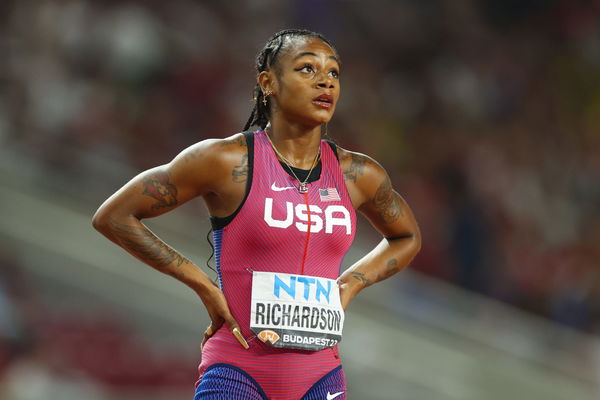
via Getty
BUDAPEST, HUNGARY – AUGUST 21: Sha’Carri Richardson of Team United States reacts after competing in the Women’s 100m Semi-Final during day three of the World Athletics Championships Budapest 2023 at National Athletics Centre on August 21, 2023 in Budapest, Hungary. (Photo by Steph Chambers/Getty Images)

via Getty
BUDAPEST, HUNGARY – AUGUST 21: Sha’Carri Richardson of Team United States reacts after competing in the Women’s 100m Semi-Final during day three of the World Athletics Championships Budapest 2023 at National Athletics Centre on August 21, 2023 in Budapest, Hungary. (Photo by Steph Chambers/Getty Images)
Ahead of the Paris Olympics, the track and field world finds itself in a complex relationship with Nike. The controversy erupted with the unveiling of the Paris Olympics kits for Team USA track and field athletes. Despite Sha’Carri Richardson being a brand ambassador for Nike, the unveiling of the uniforms didn’t escape criticism, especially for their design, and from women athletes, who took umbrage with the design of the high-cut leotards.
The controversy intensified when fans of Shelly-Ann Fraser-Pryce expressed dismay over Nike’s omission of a statue honoring her alongside other athletes like Sha’Carri Richardson and LeBron James in Paris. The omission triggered a social media uproar, with many questioning why Fraser-Pryce, with her remarkable track record and achievements, was overlooked. Adding to the tumult surrounding the multi-million dollar sports brand, a fresh controversy emerged, this time involving a track and field paralympian.
ADVERTISEMENT
Article continues below this ad
A Paralympian holds Nike accountable for their lack of inclusivity for disabled athletes
In a post on Instagram on April 21, 2024, Stefanie Reid, a track and field Paralympian who competes for both Canada and Great Britain, shared a reel about Nike’s response to her viral request. She had asked Nike if she could buy just one running shoe because she only needed one when she ran. In the video, Reid pointed out that this wasn’t an unusual request, considering Nike’s use of mannequins showcasing disabilities, some visibly wearing just one shoe. However, Nike’s response was a firm no.
View this post on Instagram
Instead, they directed her to their “One Shoe Bank” policy, which allows single-leg amputees to request one shoe free of charge annually. While Reid appreciated that this policy might help other amputees, she felt Nike could do better. Firstly, the policy was only open to US residents, and she lived in the UK. Secondly, the shoes provided through the “Nike One Shoe Bank” did not offer a choice of shoe model; one could only specify the size and which side foot the shoe was needed for (right or left), with only a general category shoe available.
ADVERTISEMENT
Article continues below this ad
As a bronze medalist in the 200m at the 2008 Summer Paralympics and silver medalist in the long jump at the 2012 Summer Paralympics, Reid emphasized the importance of having the right shoe model, as all runners know that their feet absorb a lot of impact and they need the model that’s right for them. Additionally, the policy allowed for only one shoe request per year, whereas most runners go through 3 to 5 pairs annually. Reid stated, “Ultimately, I would rather pay for a shoe that I want than have a free shoe that’s not optimal.” As we reflect on this, let’s understand why Stefanie Reid requested just one shoe in the first place.
Why did Stefanie Reid highlight this issue?
On April 10, 2024, Stefanie Reid took to her Instagram account to voice her concerns. As a track and field Paralympian who lost part of her right leg in an accident at 16, she expressed appreciation for companies using amputee mannequins, understanding the significance of such representation. However, she emphasized that if companies chose to use such images; they needed to back it up with action. In her post, she highlighted the disparity between feel-good marketing and actual inclusivity in business practices, urging for changes in policies and procedures across the board.
ADVERTISEMENT
Article continues below this ad
Reid shared her experience of reaching out to Nike’s customer care after seeing amputee mannequins in their stores. When she asked if she could purchase just one shoe, as she only needed one, Nike’s response was a simple no, accompanied by a onetime 10% discount offer. Despite declining the offer, Nike later extended a 15% discount. Dissatisfied with the response, Reid pointed out that many other brands, like Decathlon and Brooks, also used Blade Runner mannequins but had similarly unaccommodating customer service policies.
For Reid, the issue was clear: “Now I love that companies are using amputee mannequins, but if you are going to use the image, you have to back it up in the way that you do business.” Following her recent video, Nike reached out to Reid to discuss her concerns directly, and she is eager to share her ideas with the brand. As discussions continue, there is hope for more resolutions and greater equality for amputees and athletes with disabilities. What are your thoughts about this situation? Comment below!
ADVERTISEMENT
ADVERTISEMENT
ADVERTISEMENT
